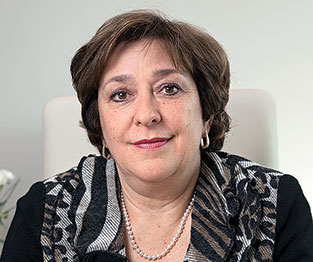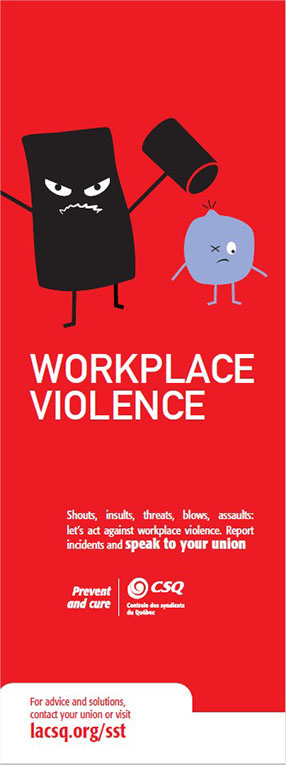Teachers who are bullied in class. Childcare educators who are pushed or hit. Nurses who are victims of physical violence, hateful language or inappropriate remarks. The education and health sectors occupy the top two ranks in CNESST1 statistics on violence in the workplace. In 2017, of 2 408 claims accepted in this category, 22.5% originated with teaching staff, and 37% with healthcare employees.
“One of the major priorities of the Centrale is to address the root causes that jeopardize the health of public service employees. And violence at work, whatever form it takes, is one of the challenges,” says Sonia Ethier.2
The tip of the iceberg
However, these numbers do not fully reflect reality because they only take into account accepted claims for which the CNESST awarded compensation. Only 40% of cases of workplace violence are the subject of a claim. Many events are not even reported to the employer.
Polls conducted in 2017-2018 with members of the FSE-CSQ3 and the FPSS-CSQ4 have brought the real situation to light. For the FSE-CSQ, the study was conducted with special education teachers. The data reveal that 68% of respondents had been victims of assault during the 24 months preceding the poll. Of these assaults,
| 84 % were verbal |
52 % were physical |
24 % were related to psychological violence |
“It’s high time we intervened in classrooms to put a stop to these kinds of situations,” says Josée Scalabrini.5 Violence has become very common in the schools, and all acts of violence are unacceptable. Above all, people should not hesitate to report such incidents so that they are not ignored.”

The profile for school support staff is not much better. Of the 2,000 members who responded to the poll, 71% had been subjected to violence over the course of the previous year. The percentage is much higher among staff who provide direct services to students (82%), but is still very high among administrative personnel (41%) and manual workers (33%).

“In addition to not being respected or recognized for their full worth, support staff members in schools are subjected to physical and verbal violence which severely affects them,” adds Éric Pronovost.6
In colleges, “anxiety and other mental health problems experienced by a growing number of students creates a climate that is conducive to violence toward CEGEP staff, because of the lack of resources,” says Lucie Piché.7 “The phenomenon of sexual violence in higher education should also be better documented so that strategies can be developed to address the realities of the educational environment.”
51 %
OF SPECIAL
EDUCATION TEACHERS
VICTIMS OF VIOLENCE
stated that school principals,
once informed, trivialized the
situation, did not know what to do,
or took no action.8
In healthcare, the majority of violent incidents can be attributed to the impacts of staff shortages. According to Claire Montour,9“healthcare staff are caught between increasingly unstable patients and an administration that never stops expanding the workload and the monitoring processes, while at the same time cutting back on the available resources. All of this is compounded by a blatant lack of time and work tools.”
Victim or witness, same impacts
The consequences of violence in the workplace are multiple. Beyond the physical scars that may result from an assault, there may also be psychological impacts: nightmares, sleep disorders, hypervigilance, avoidance, etc. Such impacts also occur among witnesses.

The violence that has been experienced explains to a significant degree why teachers at the start of their careers abandon the teaching profession. In education and in health, 50% of short- or long-term leaves are due to psychological reasons. In a context of shortages, this only increases the workload of those who remain.
Trivialization as a defensive strategy
Many people consider violence as a normal occurrence in service-sector jobs. Employers encourage a degree of omerta for the sake of their institution’s reputation. For people confronted with violence, remaining silent is also a way of distancing themselves from it. Worse still, employees avoid reporting certain situations for fear their employer or their coworkers will view them as incompetent.
Such trivialization and the feeling that nothing will be done feeds under-reporting, which in turn causes reluctance to implement preventive measures because of lack of relevant data. That is how the vicious cycle of complacency creeps in.
“For people whose vocation is to take care of vulnerable people, reporting can be difficult, but it is necessary. Tolerance normalizes the problem. And the quieter we are, the less we help the network to identify and take action on the true causes of violence,” explains Claire Montour.
 The importance of talking about it
The importance of talking about it
Obviously, talking about what we experience allows us to express our feelings and helps us analyze events. It also enables us to realize that we are probably not the only person to experience this situation. It has been shown that mutual aid and the support of colleagues are significant protection factors for psychosocial risks in the workplace.
Similarly, “reporting an act of violence to an employer enables you to be formally recognized as a victim or a witness, in addition to helping the employer to understand how this happened. Then, the employer can refer the employee to the assistance program or support the employee in filing his or her claim with the CNESST,” explains Luc Bouchard.10
His colleague Matthew Gapmann10 adds that “this way, the employer can have a realistic profile of the situation with a view to prevention. If there is an occupational health and safety committee, it’s the ideal forum for dealing with the subject.”
The union can help employees and support them in the steps they take with the employer. When several employees are experiencing the same problem, the union can also bring them together and help them find a strategy together to resolve the issues.
Legal obligations
Did you know that under the Act respecting occupational health and safety, every employer must take the necessary measures to protect the health and ensure the safety and the physical well being of his workers?11 This involves the analysis of risks in order to eliminate them or failing that, to control them. Since January 1, 2019, all employers must have and make available a psychological harassment prevention and complaint processing policy.
In education, the Act to prevent and stop bullying and violence in schools requires educational institutions to adopt and implement an anti-bullying and anti-violence action plan to prevent and put an end to all forms of bullying and violence against students and school staff members.
In the case of CEGEPs and universities, the Act to prevent and fight sexual violence in higher education institutions is designed to strengthen actions to prevent and combat this problem.
Campaign : The problem is not in your head
1 Commission des normes, de l’équité, de la santé et de la sécurité du travail.
2 Sonia Ethier is the President of the CSQ.
3 Fédération des syndicats de l’enseignement.
4 Fédération du personnel de soutien scolaire.
5 Josée Scalabrini is the President of the FSE-CSQ.
6 Éric Pronovost is the President of the FPSS.
7 Lucie Piché is the President of the Fédération des enseignantes et enseignants de cégep (FEC-CSQ).
8 FSE poll conducted with special education teachers (2017-2018).
9 Claire Montour is the President of the Fédération de la Santé du Québec (FSC-CSQ).
10 Luc Bouchard and Matthew Gapman are occupational health and safety advisors with the CSQ.
11 Compilation of Québec Laws and Regulations (CQLR), ch. S-2.1, section 51.
